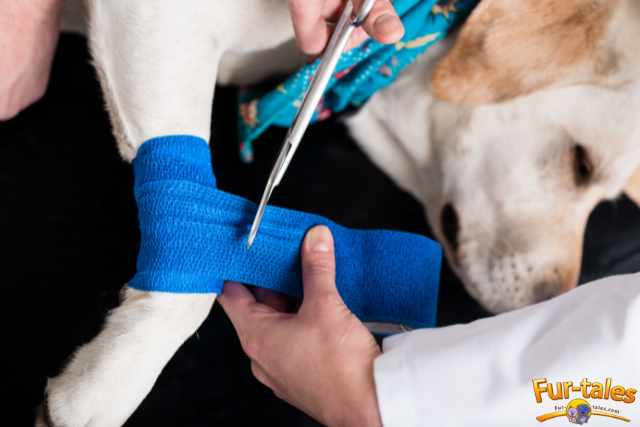
Helping Your Pet in a Crisis: First Aid Tips for Emergencies
When a pet emergency strikes, time is critical—and knowing what to do can mean the difference between life and death. Whether it’s a sudden accident, allergic reaction, heatstroke, or poisoning, basic pet first aid knowledge empowers you to act quickly and calmly in those crucial first moments before professional help is available.
Just like children, pets rely on us completely in times of distress. Being prepared not only helps you feel more confident but also ensures your beloved companion has the best chance of recovery. This guide outlines first aid tips every pet owner should know, what to include in your pet’s emergency kit, and when to head to the vet.
Let’s explore how to be your pet’s first responder in a crisis.
Why Pet First Aid Matters
The Golden Hour
In medical emergencies—human or animal—the first 60 minutes after a traumatic injury or critical health episode is known as the “golden hour.” Rapid intervention can stabilize your pet and reduce the risk of complications.
Reduce Panic, Save Time
When you’re familiar with pet first aid, you’re less likely to freeze or panic. You’ll be able to:
- Assess the situation accurately
- Apply immediate, appropriate care
- Communicate clearly with emergency vets
It Buys Time
Even when professional care is needed, proper first aid buys your pet precious time while you travel to the vet.
Emergency Pet First Aid Basics
Check Vital Signs First
Before giving aid, always assess your pet’s airway, breathing, and circulation (ABC).
A – Airway
Is your pet choking? Is the mouth clear of obstructions?
B – Breathing
Is your pet breathing normally, shallowly, or not at all?
C – Circulation
Can you feel a pulse or heartbeat? Are the gums pink or pale?
Important: If your pet is unresponsive or not breathing, perform CPR immediately (instructions below).
CPR for Dogs and Cats
Only use CPR if your pet is unconscious, unresponsive, and not breathing.
Step-by-Step Pet CPR
- Lay your pet on its side on a firm surface.
- Check for breathing and heartbeat. Look for chest movement and place fingers on the chest or inner thigh.
- Begin chest compressions:
- For dogs over 30 lbs: Use both hands, interlocked, on the widest part of the chest.
- For small dogs/cats: Use one hand or thumbs and fingers on either side of the chest.
- Compress at a rate of 100–120 per minute.
- Rescue breaths:
- Close your pet’s mouth and breathe into the nose.
- Give one breath every 5–6 compressions.
- Continue for 1–2 minutes, then check for breathing. If no improvement, continue until help arrives or your pet revives.
Common Pet Emergencies and What to Do
Choking
Signs:
- Pawing at the mouth
- Difficulty breathing
- Gagging or retching
- Blue lips or gums
What to Do:
- Gently open your pet’s mouth and look for a visible object.
- Do not blindly reach in unless you see the object.
- For small pets: Lift by hind legs and shake gently.
- For large dogs: Perform a modified Heimlich maneuver by applying firm pressure to the abdomen just below the ribs.
Bleeding
Signs:
- Visible blood from wounds
- Bleeding from nose, mouth, or rectum
What to Do:
- Apply direct pressure with a clean cloth or bandage.
- For leg wounds, wrap with gauze and secure with tape.
- Elevate the limb if possible.
- Apply pressure for 5–10 minutes continuously.
- If bleeding is severe or doesn’t stop, go to the vet immediately.
Fractures or Sprains
Signs:
- Limping or refusal to bear weight
- Swelling or visible deformity
- Yelping when touched
What to Do:
- Muzzle your pet if needed (injured pets may bite in pain).
- Do not try to reset the bone.
- Immobilize the limb with a makeshift splint (rolled towel, magazine).
- Carry your pet gently to the vet.
Poisoning
Signs:
- Vomiting or diarrhea
- Drooling or foaming at the mouth
- Seizures or tremors
- Collapse or confusion
Common Toxins:
- Chocolate, grapes, onions, xylitol (in gum)
- Human medications
- Household cleaners
- Rodenticides, antifreeze
What to Do:
- Call the ASPCA Animal Poison Control (888-426-4435) or Pet Poison Helpline (855-764-7661).
- Do not induce vomiting unless instructed.
- Bring packaging or the substance (if safe to do so) to the vet.
Heatstroke
Signs:
- Excessive panting
- Bright red gums
- Weakness or collapse
- Vomiting, seizures
What to Do:
- Move your pet to a cool, shaded area.
- Dampen with cool (not cold) water.
- Offer small amounts of water.
- Use a fan if available.
- Get to a vet immediately—heatstroke can be fatal.
Seizures
Signs:
- Sudden collapse
- Paddling legs, foaming at mouth
- Loss of bladder or bowel control
What to Do:
- Stay calm and do not restrain your pet.
- Remove nearby hazards or sharp objects.
- Note how long the seizure lasts.
- Afterward, keep your pet quiet and contact your vet.
Eye Injuries
Signs:
- Squinting or pawing at the eye
- Discharge or cloudiness
- Swelling or redness
What to Do:
- Prevent your pet from scratching.
- Flush the eye gently with saline solution.
- Avoid touching or applying ointments unless advised.
- Seek immediate veterinary attention.
Insect Bites and Allergic Reactions
Signs:
- Swelling (especially around face or eyes)
- Hives or itchy skin
- Difficulty breathing
What to Do:
- Apply a cold compress to reduce swelling.
- For mild reactions, Benadryl may be used (under vet guidance).
- Severe reactions require emergency care immediately.
What to Keep in Your Pet First Aid Kit
Every pet owner should have a dedicated pet first aid kit at home and one for travel.
Essentials:
- Gauze pads and rolls
- Adhesive tape (vet wrap or medical tape)
- Hydrogen peroxide (to clean wounds or induce vomiting under vet instruction)
- Digital thermometer
- Tweezers and scissors
- Saline solution (for eyes and wounds)
- Non-stick bandages
- Disposable gloves
- Towel or blanket
- Muzzle (even soft injuries can trigger biting)
- Flashlight
- Copies of medical records and vaccination history
- Emergency vet and poison control contact info
Tips for Emergency Preparedness
Know Your Vet and ER Locations
- Keep your vet’s number on your phone and posted on the fridge.
- Identify the nearest 24-hour animal ER.
Practice Handling Your Pet
- Get your pet comfortable with being touched on the mouth, paws, and ears. This helps during treatment.
Take a Pet First Aid Course
- Organizations like the American Red Cross offer online pet first aid and CPR classes.
When to Call the Vet vs. When to Go Immediately
Call Your Vet First If:
- Mild vomiting or diarrhea (without blood)
- Small cuts or scrapes
- Slight limping or paw sensitivity
- Flea or tick discovery
Go Immediately If:
- Difficulty breathing
- Heavy bleeding
- Seizure lasting over 3 minutes
- Suspected poisoning
- Collapse or unconsciousness
- Heatstroke or hypothermia
Image Designed Using Canva
